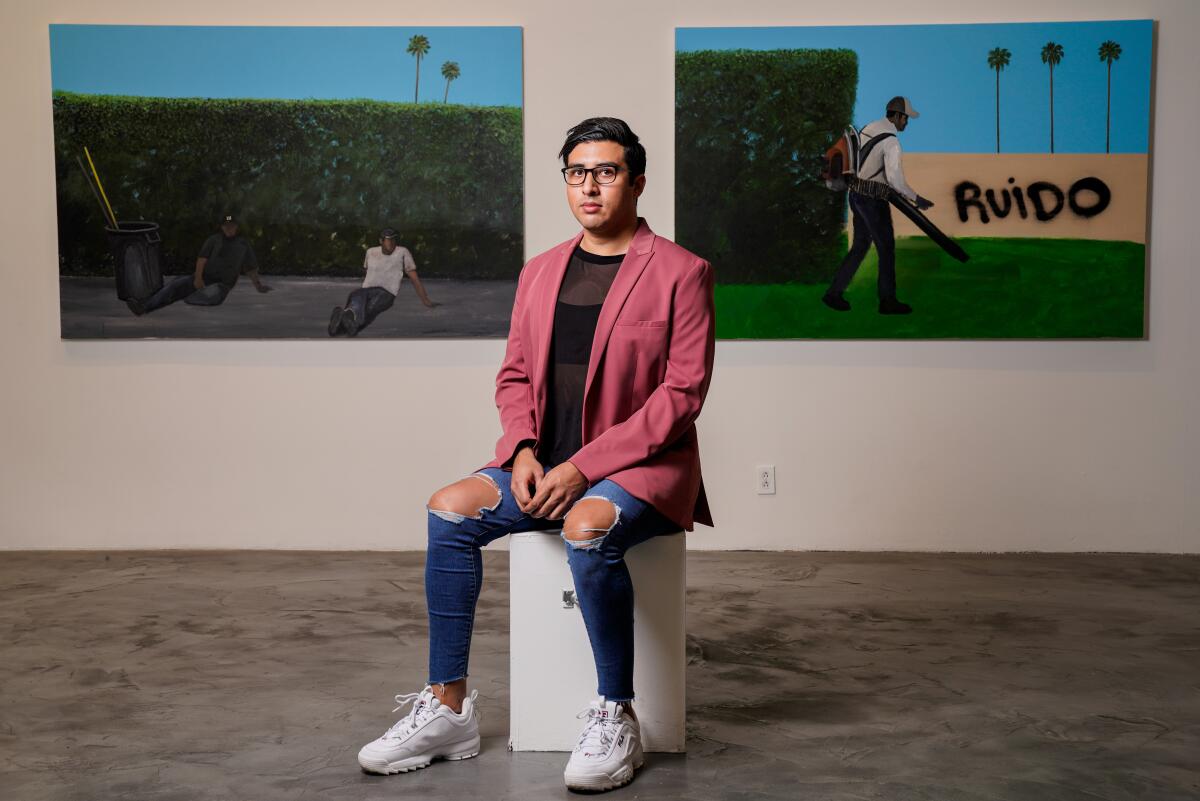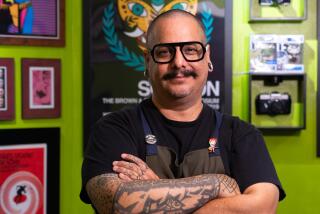He went from nanny to artist. His muse is the men and women who make L.A. work

When he was a boy in San Bernardino, Ramiro Gómez Jr. shared his dreams of becoming an artist with his grandmother.
From his dreams, he vowed to make hers come true: “When I grow up, I’m going to buy you a house,” he told her.
Gómez — whose parents are Mexican immigrants who once lived in the country illegally — did grow up to be an artist.
Today, his work sells for thousands of dollars. It’s part of museum collections, including at the Los Angeles County Museum of Art. He’s been a guest lecturer at UCLA, Duke and Harvard. He has an upcoming show with the Art Dealers Assn. of America in New York. And he just wrapped up another one at the Charlie James Gallery in Los Angeles.
His grandmother, however, was not around to see it. She died just as his career as an artist was taking off.
Lately, Gómez has been watching a lot of Harry Potter movies. The films provide him with a sense of respite, “a way to cope with the responsibility on my shoulders,” he said. But when he saw the third film in the series, directed by the Academy Award-winning Mexican filmmaker Alfonso Cuarón, it left him in emotional shambles.
In it, Gómez explained, the main characters get hold of a “time-turner,” a trinket that enables them to travel through time to alter the past and change the present.
The artist thinks a lot about 2009.
That was the year he dropped out of the California Institute of the Arts — despite his parents’ sacrifices. That was the year he began working at a child-care center and discovered that he enjoyed that more than going to class.
That was the year his now-husband, film editor David Feldman, suggested that he work as a nanny to help make ends meet.
And that was the year he watched his grandmother’s health deteriorate. The year she died of a heart attack.
“That year was hard,” Gómez said. “I felt the full failure.”
From that failure sprang a career whose muse is L.A. and the people who make it work. Literally.
After dropping out of art school, he became a full-time nanny and, while the children he cared for took a nap, he engaged in a quiet rebellion: He pored through his bosses’ discarded lifestyle magazines. Then he inserted figures of the often overlooked domestic workers who make it all possible.
At the Charlie James Gallery in Los Angeles’ historic and gentrifying Chinatown, visitors encountered a large green-blue canvas on which a gardener with giant bird wings starts to take flight. His lawnmower and his day-to-day duties are left behind.
Another piece, titled “Ruido,” featured a yard being tended to by a man carrying a leaf blower. The piece, Gómez said, was inspired by actress Julie Newmar, who is best known for her portrayal of Catwoman. When her neighbor in Brentwood refused to stop his Latino gardener from using the machine, the actress spray-painted the Spanish word for “noise” on his wall.
In “After the Fire,” three exhausted firefighters lay to rest beside luxurious outdoor patio furniture, a charred hillside in the background. Beside them, a darker-skinned man in a baseball cap waters the lawn. That piece, Gómez said, was influenced by an article in The Times that details how the owners of million-dollar homes recently failed to communicate with their employees about an evacuation order during a brush fire.
Then there was “West Hollywood Park Nanny,” which, Gómez acknowledged, serves as homage to the women who taught him the ropes of the business, ultimately giving him the confidence to ask for a raise. Seamlessly interweaving English and Spanish, Gómez remembered the other nannies telling him: “Mijo, you speak English, you’re young, you’re strong. ¿Y te están pagando $10 an hour?”
Because laborers are a core part of his subject matter, Gómez is often critiqued as profiting from the toil of others. The artist himself shares this concern and addresses it in his art. In real life, it gets even more complicated. When he received payment for commissioned artwork in West Hollywood, it took him about a month to bring himself to cash the check.
Erika Hirugami, whose company, CuratorLove, places a premium on diversity in the art world, said many of the questions Gómez deals with are often not asked of others.
“The fact that he’s making a living off of his work doesn’t exclude him from the greater narrative,” Hirugami said. “He is going to be questioned for the rest of his career because he’s not a white artist in that larger narrative, but that doesn’t mean that his voice isn’t as important. That just means that he doesn’t fit the mold.”
A decade into his career, Gómez continues to push boundaries with increasingly personal work that builds on questions of labor. His father, Ramiro Gómez Sr., works as a trucker and his mother, María Elena, as a janitor.
At his show at the Charlie James Gallery, “Here, for a Moment” and “My Cousins and Aunt Without My Tío Carlos” touched on the effects of deportation on families. In the former, a woman sobs as a detained man is taken away. In the latter, a man-shaped hole in a family portrait marks the spot where a graduate’s father should have been.
In late December, the artist’s parents traveled from their home in Highland to see their internationally acclaimed son’s exhibit at the gallery.
His mother said she always thought her son would grow up to be a veterinarian because he loved animals and always peppered her with fun animal facts. But when Gómez was a student at Golden Valley Middle School, he entered a drawing contest for the team mascot.
“Well, actually,” she said, “he did so twice.”
Using his name, Gómez submitted an entry in the boys’ division. Then, his cousin Elizabeth submitted another entry, passing off another one of his drawings as her own.
“One might say he cheated,” Gómez’s mother said. With a grin, she added, “But my son won in both categories.”
In the basement of the gallery, a piece titled “Boy Playing While His Parents Are Sleeping,” featured a child clad in a skirt and fairy wings gazing at a couple asleep in an embrace. The piece, Gómez said, speaks to the importance of “finding a little temporary moment to fantasize and play.”
Plus, he said, it’s nice to see your parents resting.
“It’s because of my parents’ labor that I now have this fantasy, this ability to be creative and express myself.”
More to Read
Sign up for Essential California
The most important California stories and recommendations in your inbox every morning.
You may occasionally receive promotional content from the Los Angeles Times.











